Every year on November 1st, the small town of Sumpango, Guatemala becomes the stage for one of the most breathtaking cultural events in Central America: the Giant Kite Festival in Guatemala, known locally as the Festival de Barriletes Gigantes. If you’ve seen photos of the vibrant, towering kites online or featured in news coverage, you might think you understand the magic—but nothing compares to standing in that open field, watching it all unfold in real life.
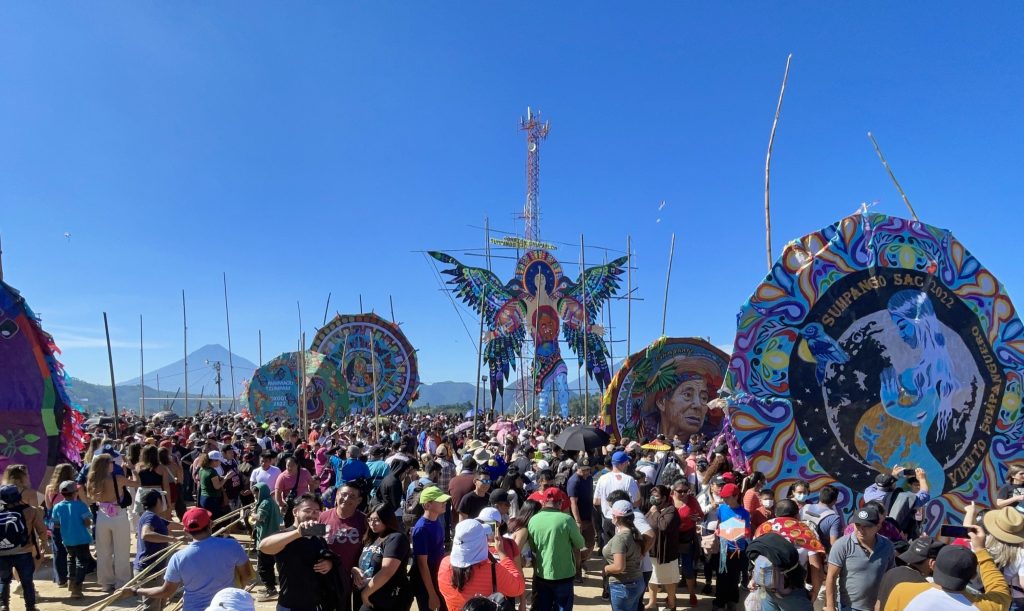
As a Guatemalan, I grew up hearing stories about the barriletes gigantes, seeing their photos in newspapers, and watching them on the evening news. But it wasn’t until I experienced the festival in person that I truly understood its emotional power. I’ve been lucky enough to attend the Sumpango Kite Festival several times, and each visit reveals something new—from the behind-the-scenes teamwork of the kite-making crews to the incredible energy that fills the air as people arrive from all over Guatemala and around the world.
Last year, I shared the experience with my dad for the first time. We arrived just before dawn and stood in awe as the enormous kites were slowly constructed and raised. The early morning chill mixed with the smell of tamales and hot atole, and we watched the transformation unfold—from quiet anticipation to vibrant celebration.

Whether you’re planning your first visit to the Giant Kite Festival in Guatemala or simply curious about this awe-inspiring tradition, this guide will take you beyond the headlines, with local tips, personal stories, and everything you need to experience one of the most unforgettable Guatemalan festivals.
What Is the Giant Kite Festival in Guatemala?
Guatemala’s Giant Kite Festival is one of the most spectacular and meaningful cultural events in Central America. Held every year on November 1st, the festival takes place in the highland towns of Sumpango and Santiago Sacatepéquez, just outside of Antigua. These are the only two communities in the country — and the world — where this vibrant tradition of building and displaying barriletes gigantes has been preserved and passed down through generations.
The festival is part of Guatemala’s All Saints Day and Day of the Dead (Día de los Muertos) traditions — a time when families honor and remember their loved ones who have passed. But instead of somber rituals, Sumpango and Santiago come alive with color, music, food, and above all, giant kites.

Visitors from across Guatemala and around the world gather in large open fields to see these towering creations, some stretching over 15 meters in diameter. While some kites are flown, many are mounted upright to showcase intricate, hand-cut paper designs that take months to complete. The atmosphere is festive, emotional, and deeply rooted in both Maya and Catholic traditions — making this festival one of the most unforgettable experiences you can have in Guatemala.
If you’re planning to be in the area for the holiday, the festival is an incredible addition to your itinerary. For a deeper look at how the holiday is observed throughout the country, check out my guide to Day of the Dead traditions in Guatemala, which explores the spiritual and cultural meaning behind the celebrationsAnd iff you’re curious about other Guatemalan celebrations, check out my guide to Festivals in Antigua Guatemala, which highlights cultural events throughout the year.
What Are the Barriletes Gigantes? The Meaning Behind Guatemala’s Giant Kites
In Guatemala, the barriletes gigantes, or giant kites, are part of a breathtaking tradition that takes place in the Guatemalan towns Sumpango and Santiago Sacatepéquez. Each year, these communities become the sole guardians of a unique cultural celebration where enormous, hand-crafted kites are constructed and displayed as part of the country’s All Saints Day and Day of the Dead (Día de los Muertos) observances.
Historically, the kites were believed to act as a spiritual bridge — messengers between the living and the dead. According to Maya Kaqchikel tradition, flying the kites helps ward off evil spirits and allows loved ones who have passed to visit and connect with their families. Over time, the kites have grown in size, complexity, and purpose, evolving into intricate, multi-meter-wide canvases made of tissue paper and bamboo, each telling a story.
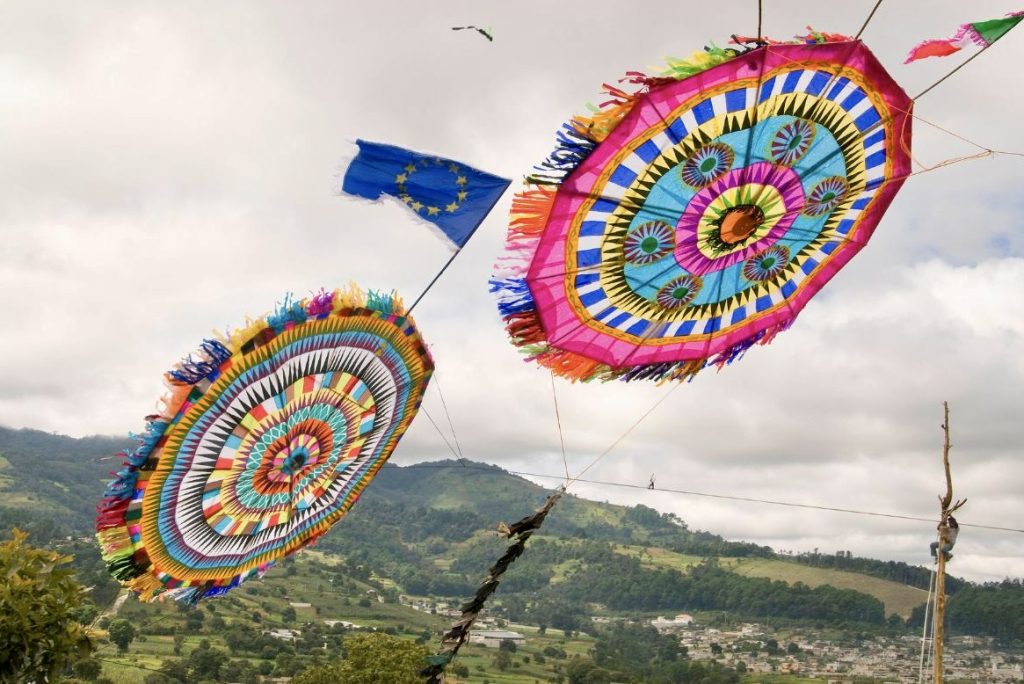
Some of the largest kites can reach up to 15 or even 20 meters (over 65 feet) in diameter, towering high above the crowds. While a few are built to fly, most are mounted upright and admired for their design and message — often held up by massive wooden structures that require entire teams to lift and secure them.
What makes the barriletes gigantes so meaningful today is how they’ve become a form of cultural and political expression. While many still honor ancestors or spiritual themes, others carry powerful messages about social justice, environmental protection, and the struggles faced by Guatemala’s Indigenous and Mayan communities. Some designs are hauntingly beautiful, others boldly defiant — each one demanding attention in its own way.
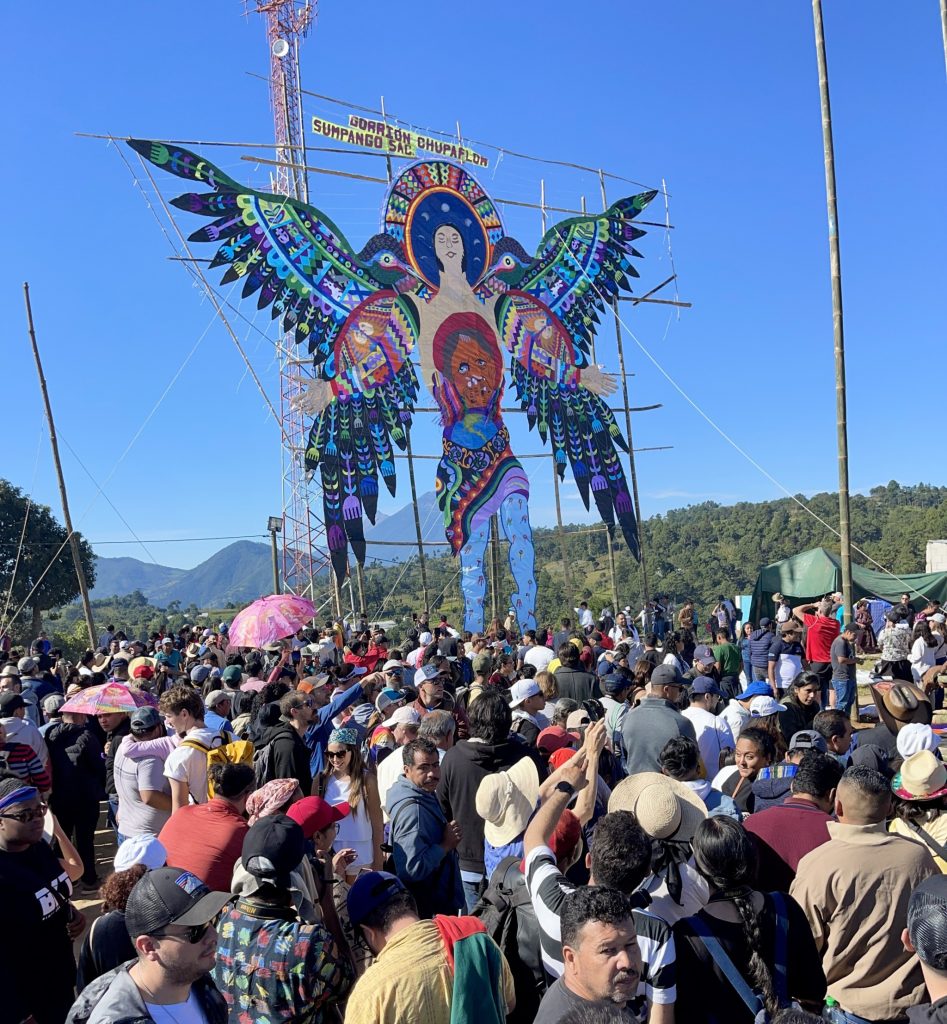
Seeing them up close, with their vibrant colors and incredible detail, is nothing like flipping through photos or watching a documentary. There’s something deeply emotional about watching the final piece — often months in the making — being carefully attached to its bamboo frame, then slowly lifted into place by a team of kite-makers who have poured their hearts and hands into its creation.
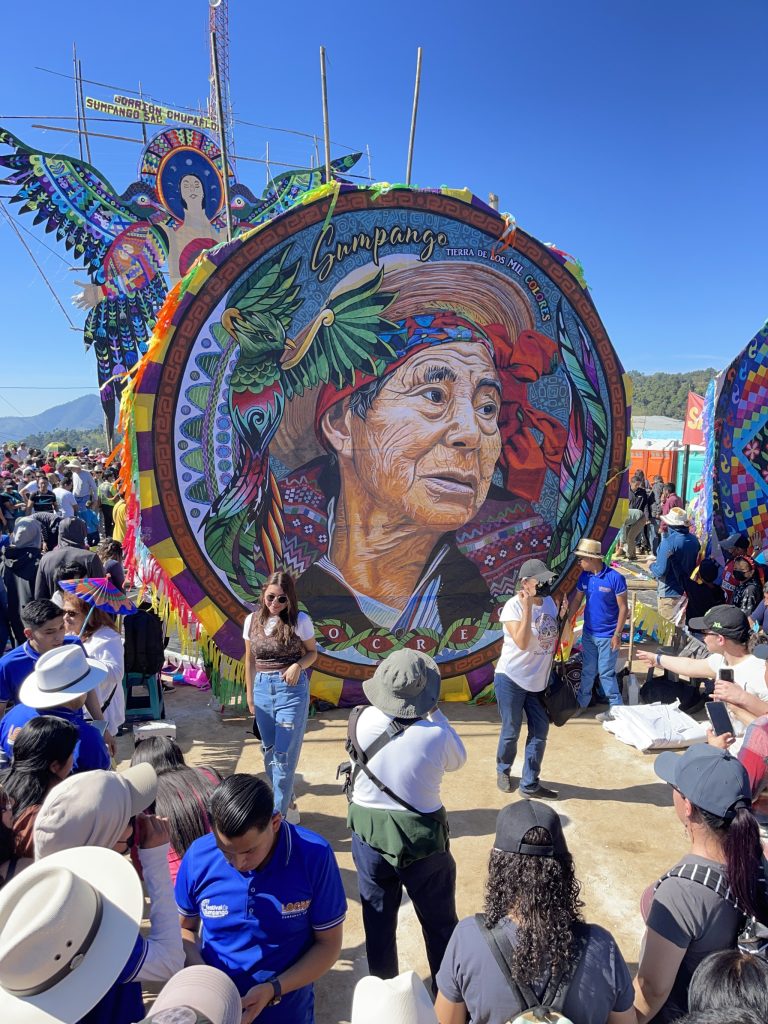
As a Guatemalan, it fills me with pride to see how these kites continue to evolve — both honoring ancestral beliefs and giving voice to the present. They are not just symbols of tradition, but living, breathing testaments to the resilience, artistry, and spirit of the people who create them. It’s one of the most powerful examples of cultural expression found in any Guatemalan festival.
Sumpango Kite Festival: When, Where, and What to Expect
The Sumpango Kite Festival takes place every year on November 1st, in honor of All Saints Day. The event is held in an open field just outside the town of Sumpango, Sacatepéquez, about an hour from Guatemala City or 45 minutes from Antigua by car, depending on traffic. If you’re planning to attend, it’s best to arrive early — not just to beat the crowds, but to experience the full magic of how the Giant Kite Festival in Guatemala unfolds.
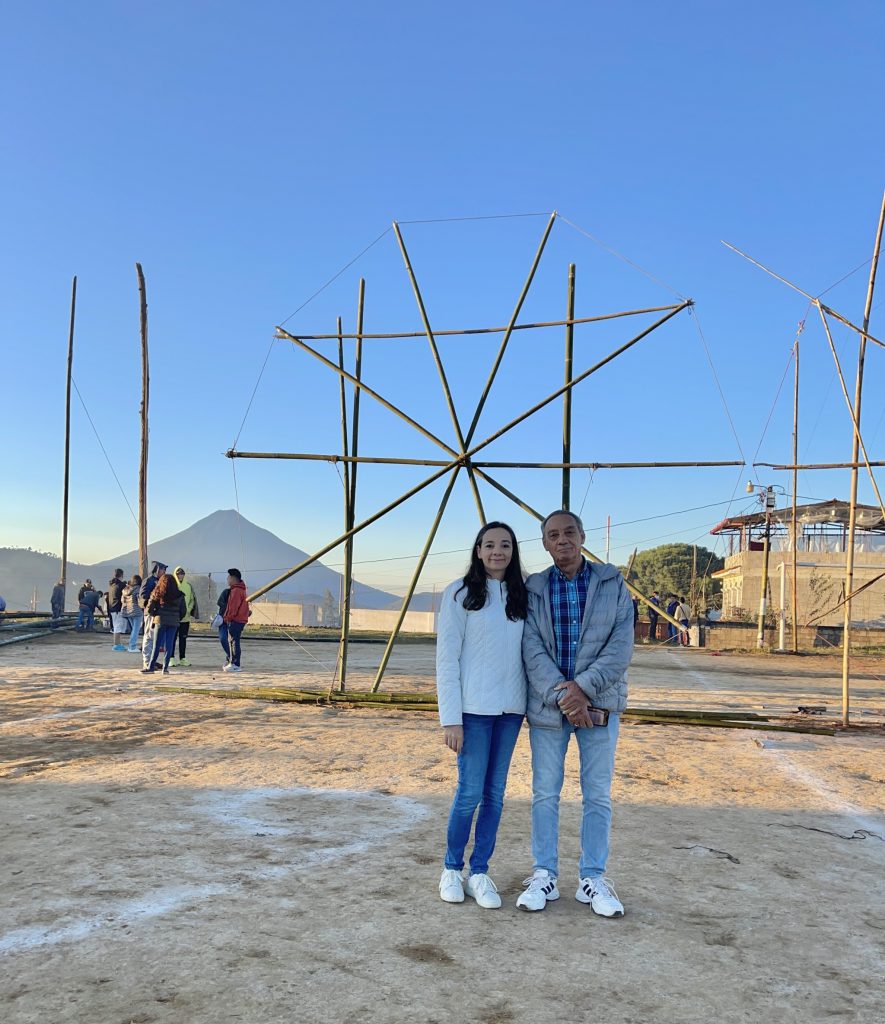
When you first arrive in the early morning, the field might look surprisingly empty. Instead of rows of giant kites already on display, you’ll see piles of bamboo poles, groups of people in matching T-shirts, and the smell of tamales and hot atolein the crisp mountain air. This is the moment before the transformation begins.
As the sun rises, the teams start assembling their structures. Each group carefully constructs the wooden framework using long poles and rope, then begins attaching the vibrant paper design they’ve spent months perfecting. This part of the process is rarely seen by tourists, but it’s one of the most emotional and meaningful parts of the day. Seeing the care and teamwork that goes into raising each barrilete gigante is truly moving.
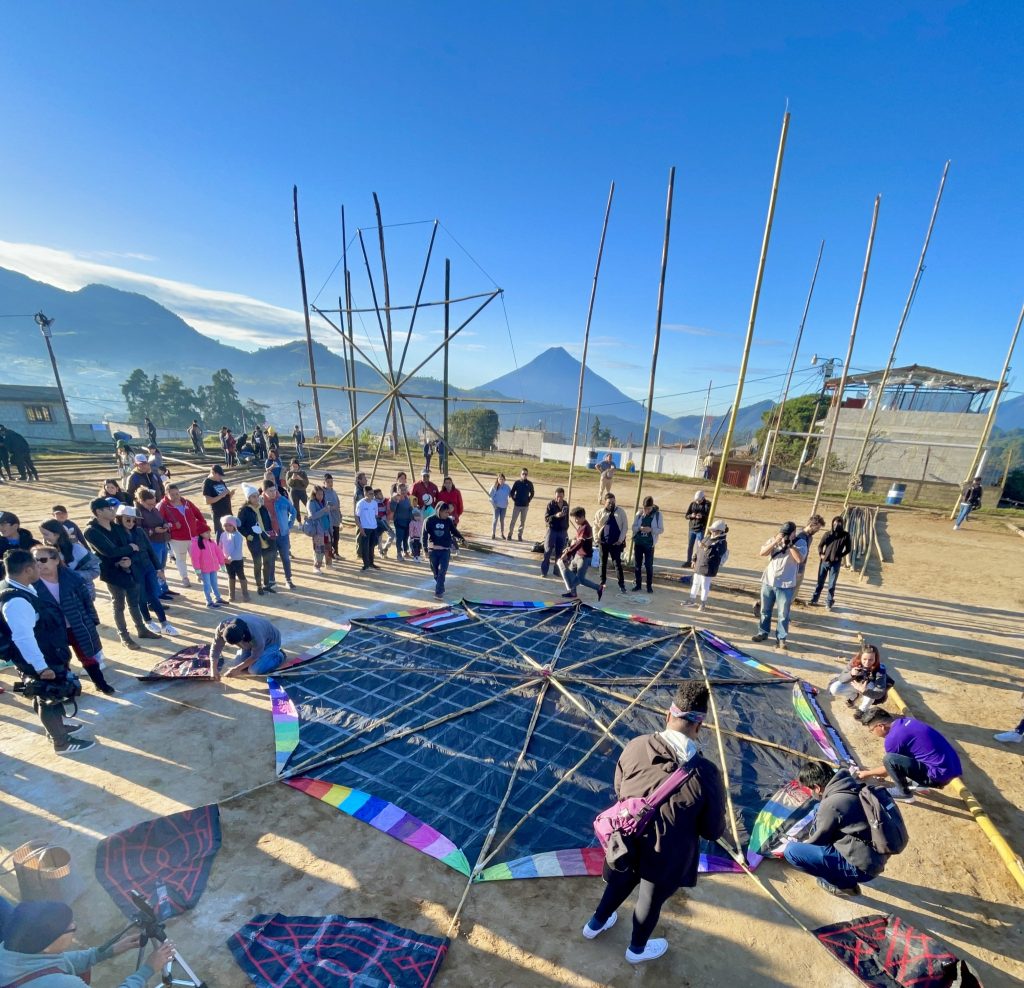
By mid-morning, the field fills with people and the kites begin to rise, one by one.. The air fills with excitement as an emcee announces the names of the kite-making teams and invites attendees to shout out where they’re visiting from. You’ll hear towns from every region of Guatemala and countries from around the world. It feels like the whole world is gathered in this one small town to witness something extraordinary.
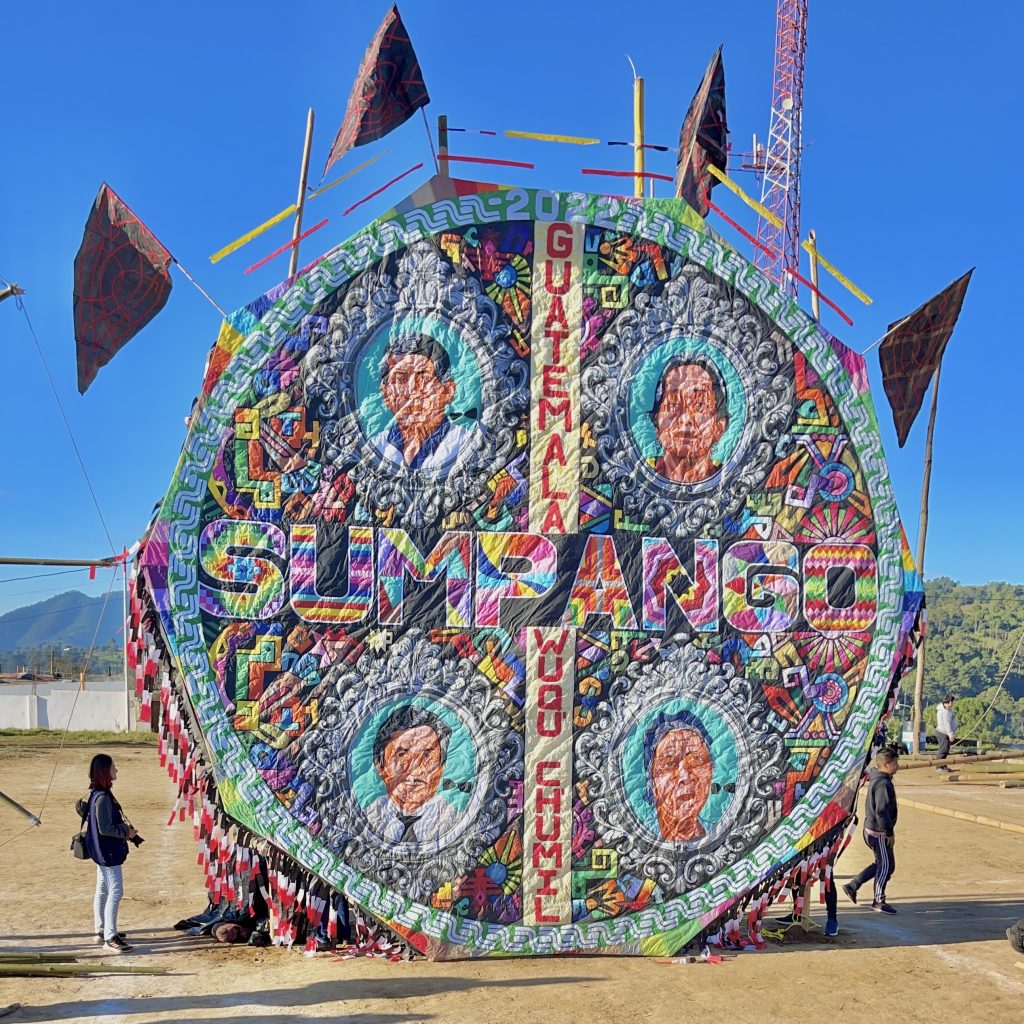
The festival continues into the afternoon, with contests, music, traditional foods, and an atmosphere that blends celebration, remembrance, and pride. Whether you’re watching the first kite rise or weaving through the crowd to see each design up close, it’s an experience that stays with you long after the day is over. It’s one of the most unforgettable Guatemalan festivals and a must-see if you’re visiting in the fall.
Insider Tips for Visiting the Sumpango Kite Festival
If you want to truly experience the Sumpango Kite Festival, not just see it, the best thing you can do is arrive early, and I mean really early. Many tours and visitors show up mid-morning or later, once the barriletes gigantes are already upright and the crowds are in full swing. But by then, you’ve missed some of the most intimate and awe-inspiring moments of the day.
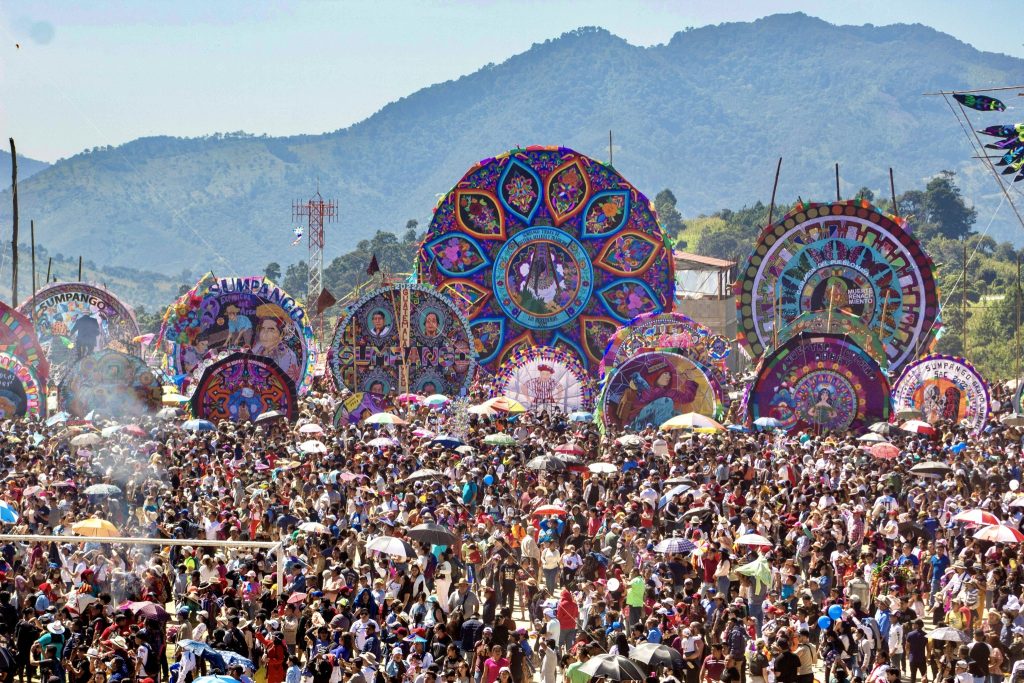
Getting there before sunrise means you’ll see the festival come to life from the very beginning. At that hour, the field is still quiet, with only a handful of locals sipping atole and warming up with tamales. You’ll witness the teams arriving, many of them young people and community groups who’ve worked for months on their kite design. There’s something incredibly powerful about watching them build the massive bamboo frames by hand and then carefully glue their intricate tissue paper artwork onto the structure. It’s teamwork, art, and ceremony all at once — and one of the most unique sights in any Guatemala festival.
Here are a few more tips to help you make the most of your visit:
- Dress in layers: It’s chilly in the early morning in Sumpango, but by midday, the sun is strong. Bring a hat, sunscreen, and something warm for the morning hours.
- Pack light but smart: Water, snacks, and tissues are essential. There are food stalls, but lines get long later in the day.
- Bring cash: Most food vendors and local artisans don’t accept cards, and there are no ATMs on site.
- Photography tip: If you want great shots with the kites, take them early. Once the field is full, it’s almost impossible to get a clear photo with a kite in the background.
- Be prepared for crowds: By mid-morning, thousands of people arrive. Stay patient, and take breaks on the edges of the field if you need space.
- Be respectful: This isn’t just a tourist event. It’s a spiritual, emotional, and cultural experience for the people who create these kites and come to celebrate their loved ones. Ask before taking close-up photos of artisans or families.
If you’ve never been, the scale and energy of the festival might surprise you. But it’s that combination — the reverence, the artistry, and the joy — that makes this event so special. It’s a beautiful example of how Guatemala blends ancient tradition with present-day expression, and a highlight of any visit during the Giant Kite Festival in Guatemala.
Quick Guide: Getting to the Sumpango Kite Festival
Location:
The festival takes place in the open field just outside the town of Sumpango, in the department of Sacatepéquez, Guatemala. It’s about:
- 45 minutes from Antigua
- 1 to 1.5 hours from Guatemala City, depending on traffic
Best Time to Arrive:
Plan to arrive by 6:00 AM if you want to see the kites being assembled and avoid the heaviest crowds. Tours and most day-trippers arrive between 9:00 and 11:00 AM, so early arrival gives you the full behind-the-scenes experience and a better sense of the Giant Kite Festival in Guatemala as a living tradition.
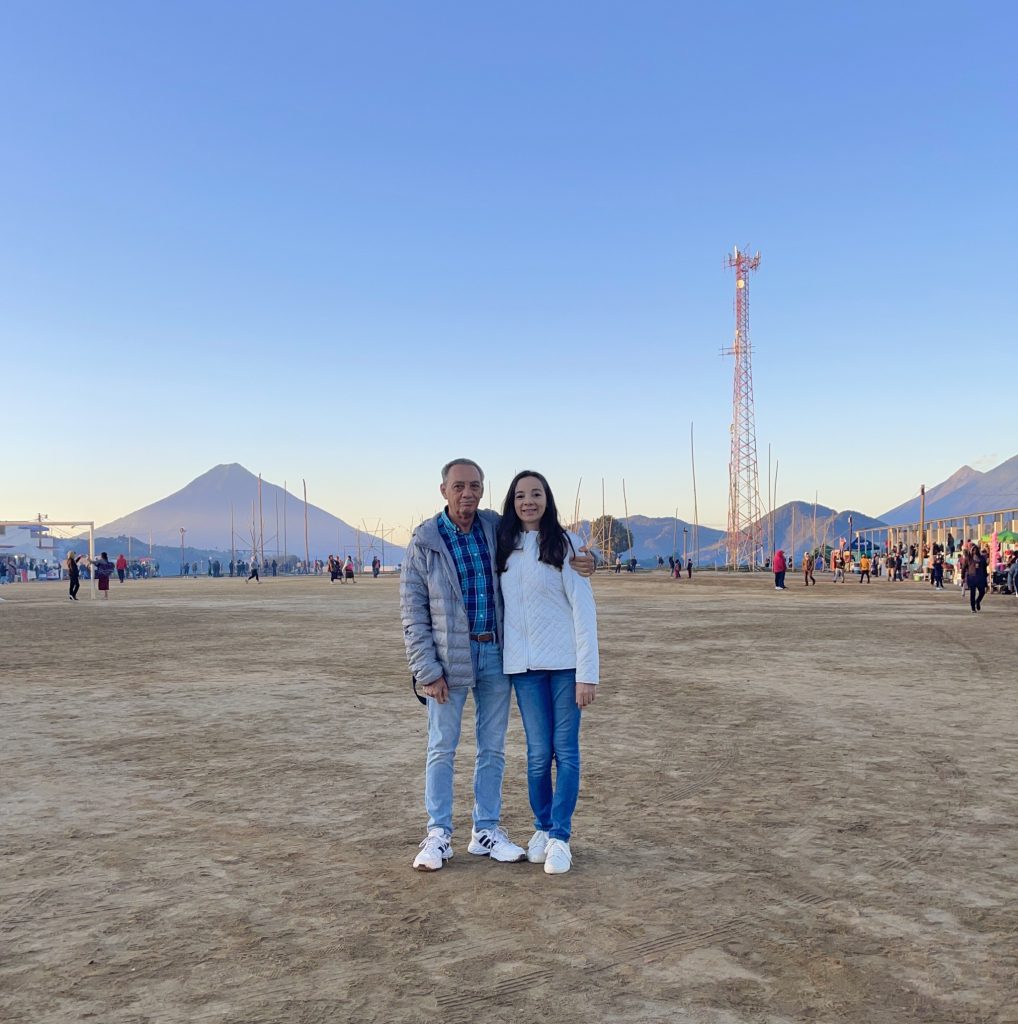
Getting There:
- Driving yourself? Get there just before dawn if you can. We arrived early and parked close to the field with no issues, but by the time we left, cars were backed up for miles trying to get into Sumpango. Many people have reported sitting in traffic for hours on the way in and again on the way out.
- By shuttle or tour? Many companies offer day trips from Antigua and Guatemala City. Confirm departure and return times, and be aware that some tours arrive after the best moments have already passed.
Parking Tips:
- Early in the morning, many of the private fields used for parking are still closed, so be prepared to park along the roadside.
- Bring small bills (Q20–Q30) for parking, as locals begin opening up their land later in the morning.
- Comfortable shoes are a must. Even with good parking, the walk to the field can be long and uneven.
- If you’re arriving late, expect to park much farther away and walk through crowds and traffic to get to the entrance.
Navigation Tip:
Use Waze or Google Maps, but expect delays if you’re coming later in the morning. Some roads are closed off for the event, and traffic control is limited. Arriving early and leaving early is the best way to avoid the worst of the traffic.
Behind the Scenes: How Guatemala’s Giant Kites Are Made
One of the most moving parts of the Sumpango Kite Festival isn’t just the moment when the giant kites go up — it’s everything that comes before that. Unless you arrive early, it’s easy to miss the incredible effort that goes into building these massive works of art, right there in the field, on the morning of the festival.
The kites, or barriletes gigantes, are made almost entirely from bamboo, rope, and tissue paper — and nothing is left to chance. The tissue paper is cut by hand into intricate designs, then glued together in massive sheets that form the front of the kite. These designs take months to plan, sketch, cut, and assemble. Most are created by local youth groups, artist collectives, or community organizations, often with a strong message — spiritual, political, environmental, or cultural.
But it isn’t until the morning of November 1st that the true test begins. Teams arrive at dawn and start laying out the long bamboo poles that will form the frame. You can see them measuring, tying, adjusting. It’s an intense and emotional process. These are huge structures — some over 15 meters in diameter — and assembling them in an open field, with the pressure of the festival and the eyes of the crowd, is no small feat.

Watching the teams carry the finished paper design, then carefully align it with the frame and glue it into place is something I’ll never forget. Everyone holds their breath as they raise the finished kite upright. The entire crowd seems to pause for a moment, and when it’s finally standing, there’s a cheer. Then they move on to the next one.
Not all of the kites are meant to fly. Many are built just to stand, supported by huge wooden posts and layers of rope. Some smaller ones are flown during the afternoon — and seeing them in the air, spinning and tugging in the wind, adds another layer of beauty and symbolism to the day.

There’s so much pride and passion in every step. This isn’t just performance — it’s memory, identity, and community. And for those who take the time to watch it unfold, it’s one of the most rewarding parts of the entire Giant Kite Festival in Guatemala.
How the Giant Kite Festival in Guatemala Connects to Day of the Dead
The Giant Kite Festival in Sumpango is deeply tied to Guatemala’s Day of the Dead traditions, but what makes it so unique is how it blends Maya Kaqchikel spirituality, Catholic ritual, and contemporary artistic expression into something completely its own.
Day of the Dead celebrations in Latin America are marked with candles, marigolds, and altars filled with pan de Puerto and offerings. In Day of the Dead Guatemala traditions, those elements are present too — especially in cemeteries where families gather to repaint graves, bring food, and spend time with their departed loved ones. But in Sumpango and Santiago Sacatepéquez, the focus shifts skyward, with barriletes gigantes acting as symbolic messengers between the living and the dead.

The idea is that by flying these massive, vibrant kites, families are able to send prayers, messages, and love into the heavens. In Maya belief, the kites help clear the sky of evil spirits so that the souls of the departed can visit in peace. It’s both protection and invitation — a way of opening the path between worlds.
Over time, the tradition has grown to include much more than just spiritual messages. Many kites now speak to what’s happening here and now in Guatemala — migration, deforestation, political struggles, and the preservation of Indigenous culture. But at its core, the day is still about remembrance. Even as thousands gather, eat, laugh, and take photos, there’s a shared sense of reverence.
If you’ve never experienced All Saints Day in Guatemala, the kite festival is a powerful place to start. It’s not a reenactment or a show — it’s a living tradition, carried forward by young hands and old hearts, connecting past and present in the most visual and heartfelt way.
And standing there in the middle of it all, as the giant kites rise slowly into the blue, you can feel that connection too — a tradition that makes the Giant Kite Festival in Guatemala one of the most meaningful cultural events in the country.
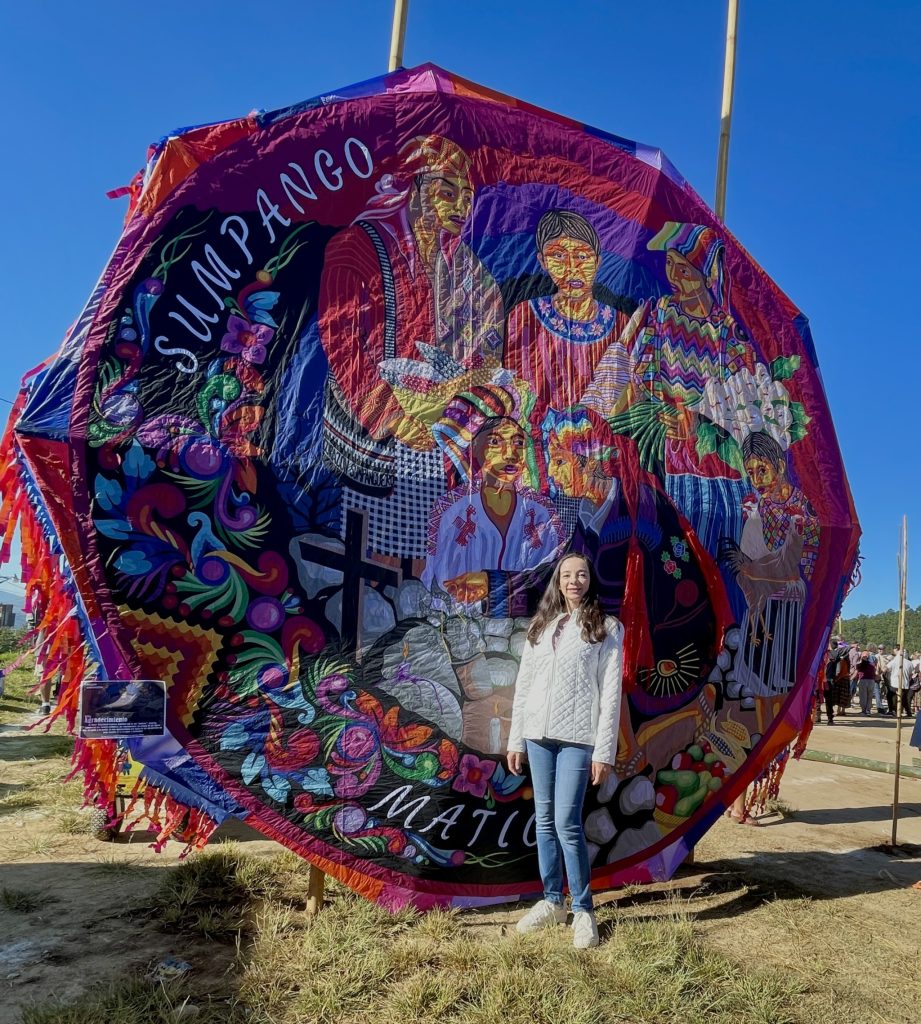
Where to Eat and Stay Near the Sumpango Kite Festival
While Sumpango is a small town without major hotels or restaurants, the festival brings the community to life with food stands, homemade meals, and temporary vendors offering everything from traditional dishes to festival treats. The experience is rustic and very local — which, in many ways, is part of the charm and reflects the heart of the Giant Kite Festival in Guatemala.
What to Eat at the Festival
Food is a huge part of the celebration. You’ll find:
- Atole: A thick, sweet corn-based drink that’s a must-have while you wait for the sun to rise.
- Chuchitos: These small tamales, wrapped in a corn husk, are easy to eat on the go and one of my favorite Guatemalan foods.
- Elotes: Grilled corn is a popular Guatemalan street food that’s easy to carry as you walk the festival grounds. I like mine with lime and salt only, but you can get it topped with mayonnaise, cheese, and hot sauce.
- Pepián: This is Guatemala’s national dish, this hearty stew is prefect to enjoy if the day is cold.
Bring small bills and coins, as vendors don’t typically have change for large denominations. Most stalls are cash-only.

Where to Stay Nearby
Since Sumpango doesn’t have traditional hotels, most visitors choose to stay in Antigua Guatemala, which is less than an hour away by car. Antigua offers everything from boutique hotels and hostels to upscale colonial-style accommodations, and it’s an ideal base for exploring the region and attending the Sumpango Kite Festival.
A few recommendations in and around Antigua:
- Hotel Casa Santo Domingo – Beautiful and historic, with a spa and museum on-site.
- Posada del Ángel – Smaller, more intimate, and perfect for couples or solo travelers.
- Earth Lodge (in nearby El Hato) – An eco-lodge with volcano views for those who want something more off-the-beaten-path.
If you’re coming from Guatemala City, you’ll find more modern hotel options, but traffic into Sumpango on the morning of the festival can be unpredictable, so Antigua is generally the better choice.
Frequently Asked Questions About the Sumpango Kite Festival
Is the Sumpango Kite Festival free to attend?
Yes, entry to the festival is free. However, you’ll want to bring cash for parking, food, souvenirs, and small purchases at local vendor stands. There’s no official entrance gate — the event takes place in an open field just outside of town in Sumpango, Guatemala.
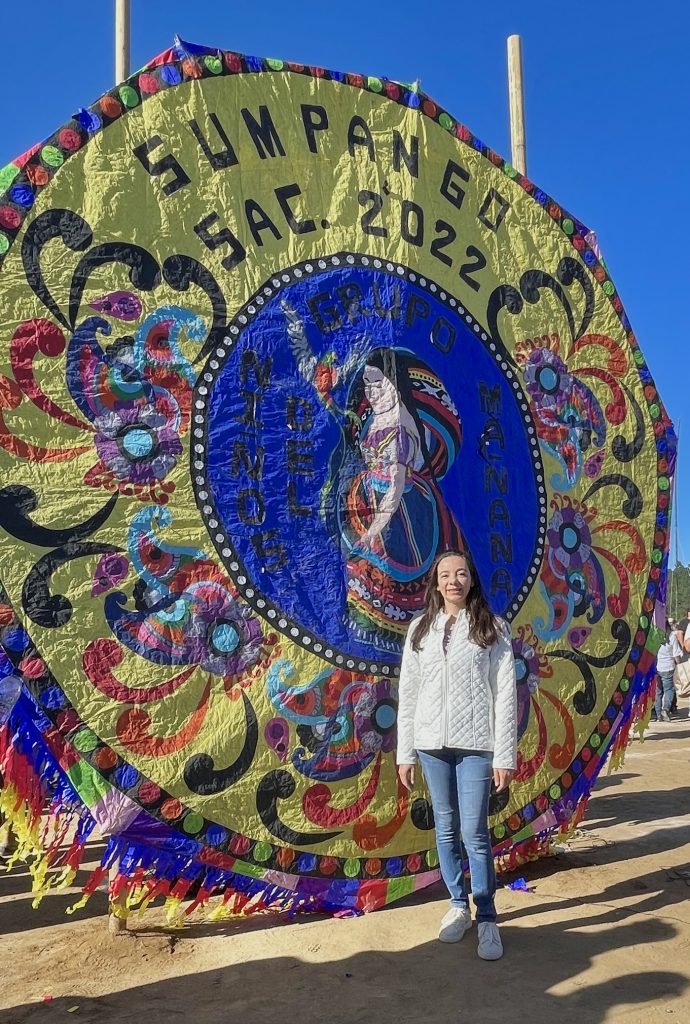
Can visitors fly kites at the festival?
You can bring and fly your own small kite in the areas surrounding the main field, but the giant kites on display are strictly handled by local teams. There are usually smaller hand-crafted kites for sale at the festival if you want to join in the fun.
Are all the giant kites flown?
No. While some of the smaller kites are flown later in the day, the largest barriletes gigantes are not designed to fly. Most are mounted upright on wooden frames for display and competition. Flying a 15-meter kite made of paper and bamboo would be nearly impossible, though it’s not for lack of creativity or skill.
How accessible is the festival for people with mobility challenges?
The terrain is uneven and mostly dirt, with few formal paths and if you park on the side of the road it’s a steep climb to the field. There are no designated accessibility areas, and crowds can get dense. If mobility is a concern, it’s best to come early and stay along the outer edges of the field where it’s easier to move around.
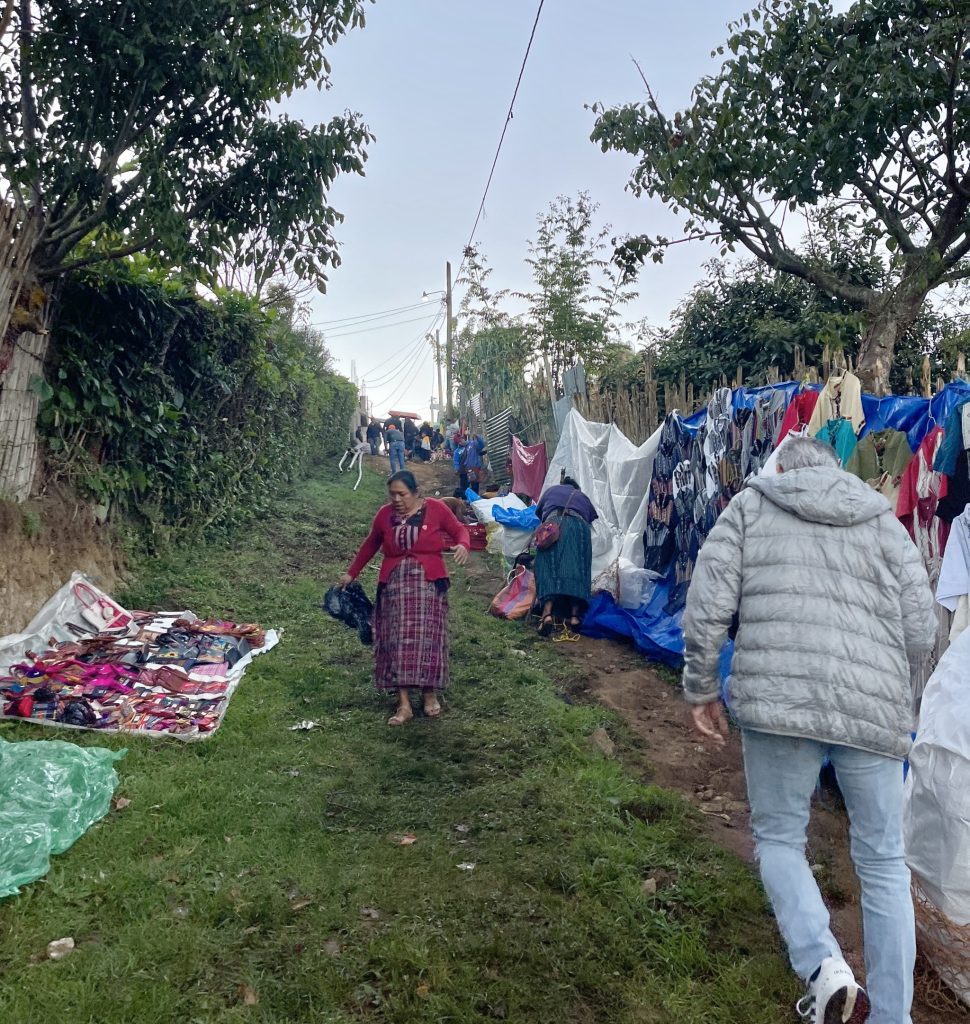
Is it safe to attend with kids?
Yes, but with a few caveats. The morning hours are calmer and more family-friendly. Later in the day, the field becomes extremely crowded, and it’s easy for kids to get overwhelmed or lost in the sea of people. Early arrival, keeping children close, and planning for breaks are key.
Can I attend both Sumpango and Santiago Sacatepéquez in the same day?
It’s technically possible, but not ideal. The two towns are close, but traffic and the scale of the events make it hard to fully enjoy both in a single day. Sumpango is more accessible and typically draws more international visitors, while Santiagohas a smaller, more intimate feel. If you’re curious about both, it’s best to visit them in different years — each offers its own unique energy.
What makes the Giant Kite Festival in Guatemala different from other Day of the Dead traditions?
Unlike more common Day of the Dead Guatemala customs like cemetery visits or altars, the Giant Kite Festival in Guatemala uses art and sky as a way to connect with ancestors. The kites are believed to help carry prayers and clear bad spirits, blending Maya Kaqchikel beliefs with modern messages and community storytelling.
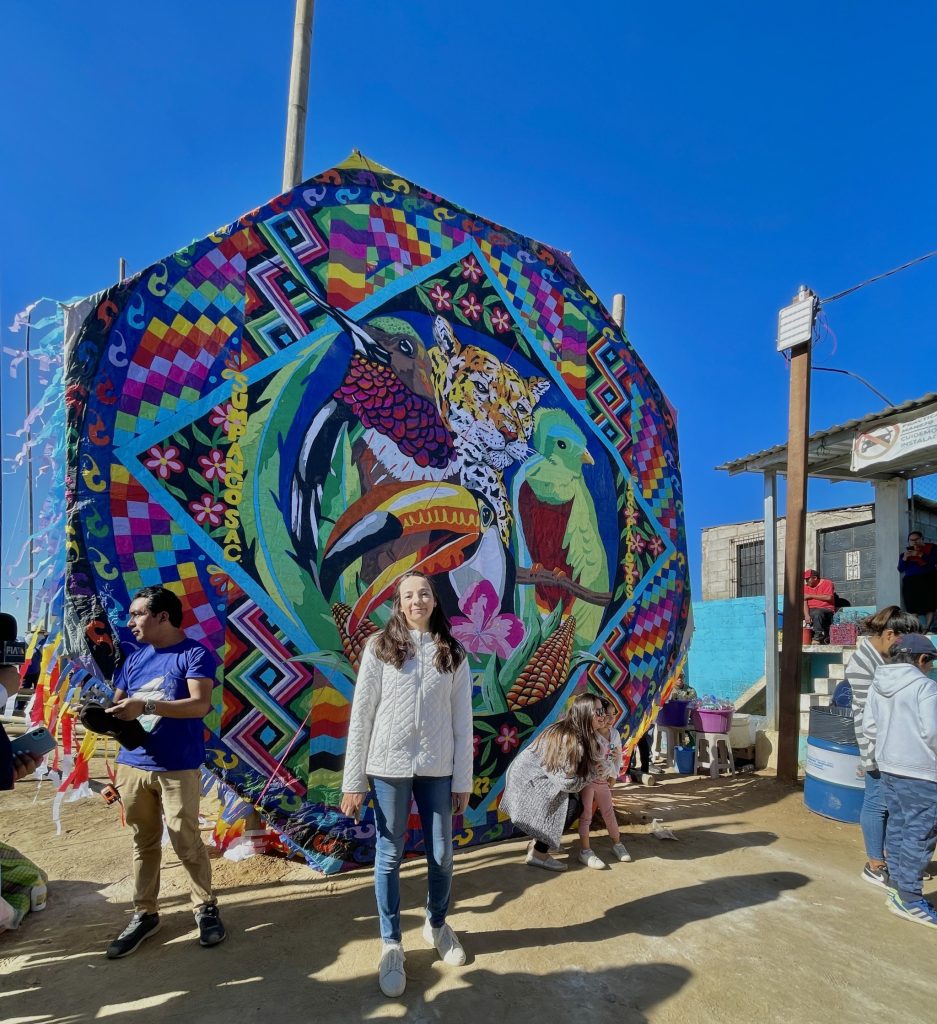
Experiencing the Giant Kite Festival in Guatemala
The Sumpango Kite Festival isn’t just a cultural event — it’s something you feel in your chest, in your skin, in your bones. From the sound of bamboo poles being tied together at dawn, to the bright colors of the barriletes gigantes rising slowly into the sky, to the voices calling out hometowns from every corner of Guatemala and beyond, it’s a day that stays with you.
For me, it’s more than tradition. It’s memory. It’s connection. Sharing this experience with my dad last year, after growing up seeing the kites only in the news and on TV, reminded me why this celebration means so much to us as Guatemalans. It’s a way of honoring our past while shaping how we’re seen in the present. These kites don’t just honor the dead — they carry messages for the living too.
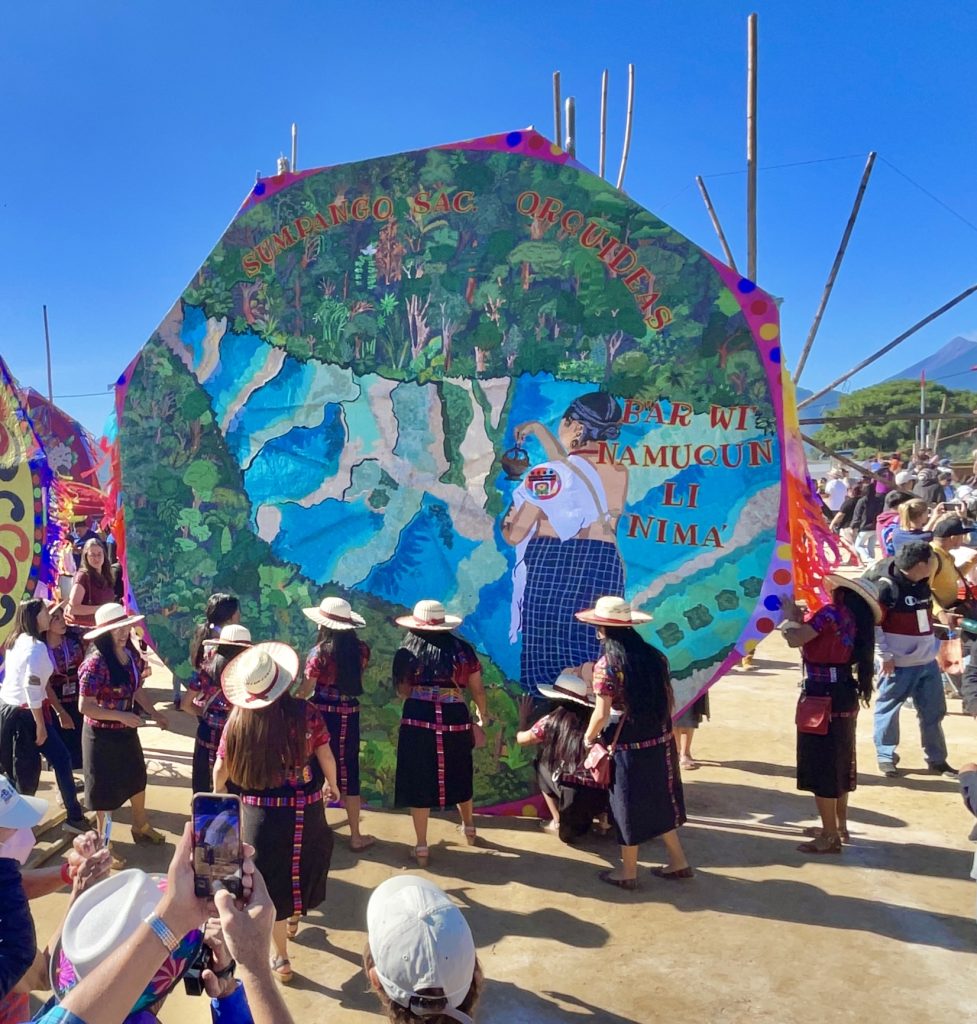
If you’re planning a trip to Guatemala in the fall, this festival is something you should absolutely make time for. But more than that, try to see it early. Watch the teams build. Walk the field before the crowds. Listen, feel, and let it unfold.
And when that first giant kite rises, you’ll understand why people from across the globe travel here to witness something that photos and videos could never quite capture — a tradition so alive, so rooted in history and meaning, that it could only belong to the Giant Kite Festival in Guatemala.
- Cranberry Brie Cake Grazing Board (An Elegant Holiday Cheese Centerpiece) - December 19, 2025
- Easy Cranberry Cocktails You Can Make All Year - December 18, 2025
- Christmas Mulled Wine (A Classic Holiday Mulled Wine Recipe) - December 18, 2025


